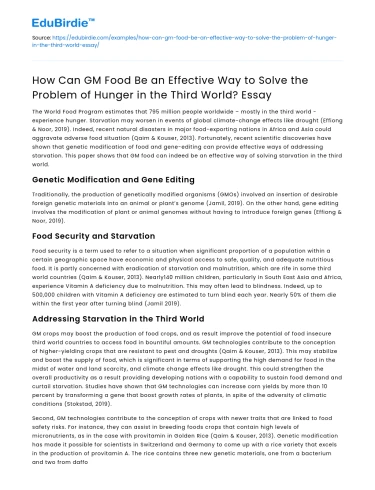The World Food Program estimates that 795 million people worldwide – mostly in the third world - experience hunger. Starvation may worsen in events of global climate-change effects like drought (Effiong & Noor, 2019). Indeed, recent natural disasters in major food-exporting nations in Africa and Asia could aggravate adverse food situation (Qaim & Kouser, 2013). Fortunately, recent scientific discoveries have shown that genetic modification of food and gene-editing can provide effective ways of addressing starvation. This paper shows that GM food can indeed be an effective way of solving starvation in the third world.
Genetic Modification and Gene Editing
Traditionally, the production of genetically modified organisms (GMOs) involved an insertion of desirable foreign genetic materials into an animal or plant’s genome (Jamil, 2019). On the other hand, gene editing involves the modification of plant or animal genomes without having to introduce foreign genes (Effiong & Noor, 2019).
Save your time!
We can take care of your essay
- Proper editing and formatting
- Free revision, title page, and bibliography
- Flexible prices and money-back guarantee
Food Security and Starvation
Food security is a term used to refer to a situation when significant proportion of a population within a certain geographic space have economic and physical access to safe, quality, and adequate nutritious food. It is partly concerned with eradication of starvation and malnutrition, which are rife in some third world countries (Qaim & Kouser, 2013). Nearly140 million children, particularly in South East Asia and Africa, experience Vitamin A deficiency due to malnutrition. This may often lead to blindness. Indeed, up to 500,000 children with Vitamin A deficiency are estimated to turn blind each year. Nearly 50% of them die within the first year after turning blind (Jamil 2019).
Addressing Starvation in the Third World
GM crops may boost the production of food crops, and as result improve the potential of food insecure third world countries to access food in bountiful amounts. GM technologies contribute to the conception of higher-yielding crops that are resistant to pest and droughts (Qaim & Kouser, 2013). This may stabilize and boost the supply of food, which is significant in terms of supporting the high demand for food in the midst of water and land scarcity, and climate change effects like drought. This could strengthen the overall productivity as a result providing developing nations with a capability to sustain food demand and curtail starvation. Studies have shown that GM technologies can increase corn yields by more than 10 percent by transforming a gene that boost growth rates of plants, in spite of the adversity of climatic conditions (Stokstad, 2019).
Second, GM technologies contribute to the conception of crops with newer traits that are linked to food safety risks. For instance, they can assist in breeding foods crops that contain high levels of micronutrients, as in the case with provitamin in Golden Rice (Qaim & Kouser, 2013). Genetic modification has made it possible for scientists in Switzerland and Germany to come up with a rice variety that excels in the production of provitamin A. The rice contains three new genetic materials, one from a bacterium and two from daffodil. The rice is currently undergoing mass distribution in famine-stricken developing nations in Africa and South East Asia (Jamil 2019). In addition, a biotechnology company called Calyxt made a remarkable breakthrough through gene editing in managing to extend the shelf life of potatoes. They disabled a single gene that encourages sugar accumulation in the tuber. They also used the technique to reduce the generation of acrylamide, a cancer-promoting agents often triggered when potato is fried. This can be particularly useful in a number of developing countries in Africa like Burkina Faso that depend on potatoes as their staple (Effiong and Noor, 2019).
Conclusion
Overall, recent scientific techniques capable of improving food production would indeed be a good thing for the world. Besides contributing to increased food production and improved accessibility to food, GM foods also contribute to improving the quality of food and composition of nutrients.






 Stuck on your essay?
Stuck on your essay?

